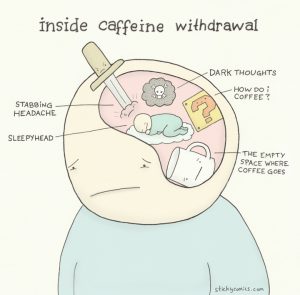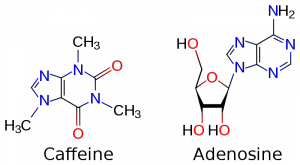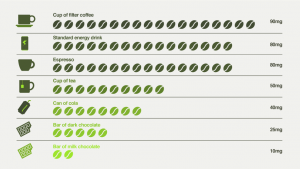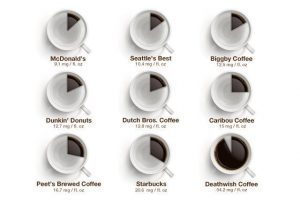MADELEINE YU | BLOGGER | SQ ONLINE (2016—17)
When one hears the phrase “drug addiction”, many images come to mind. Dark, dilapidated structures. Empty needles strewn about. Malnourished and lifeless individuals, perhaps. Needless to say, drugs are not seen with a whole lot of positivity. And why would they be? We’ve all been educated on the unhealthy effects of an addiction, whether it be through school assemblies with D.A.R.E. America or through TLC’s My Strange Addiction. So I think it’s safe to say that, if given the option, 99% of all people would not choose to be addicted to anything. And yet, most of the world has already fallen victim to a serious addiction to a psychoactive drug that is consumed on a day-to-day basis. This all-inclusive product has amassed an avid following and continues to hook new future addicts at an alarming rate. But the most shocking part? No one seems to have a problem with it.

Caffeine. Simultaneously glorious and unimaginably annoying. While at times it can make you feel like you’re a part of an exclusive elite society of bustling productivity and acoustic coffeehouse tunes with exotic terms like: “extraction” and “demitasse”, it can also make you feel pretty terrible. There is no worse way to go about your day than without coffee. Once past the usual caffeine consumption time, the effects are immediate and unforgiving. Unrelenting pressure builds up, seemingly exponentially, behind the eyes with every hour spent sans coffee. Forget about distractions–caffeine withdrawal is the distraction and it takes every ounce of control to continue behaving like a sane human being.
Fortunately, coffee is rather easy to come by and relatively cheap, making withdrawal a short-lived detractor from regular life. And when it’s dressed up in other names like latte, cappuccino, or macchiato, for instance, it makes it all the better. Of course, the one reason for jumping on the bandwagon of coffee-dependence is for the near superhuman effect that caffeine has on our bodies.
Caffeine Pharmacology
Let’s take a look into the biological mechanisms at work during caffeine consumption. Also known as 1,3,7-trimethylxanthine (cue the flashback of repressed O-Chem memories here), caffeine is a plant alkaloid, or a naturally occurring chemical compound composed of mainly nitrogen. Although not as potent, caffeine affects the brain in much of the same way as other drugs such as amphetamines, cocaine, and heroin do.
Here’s the breakdown:
- Caffeine is ingested and is rapidly absorbed through the gastrointestinal tract and distributed throughout the body.
- After 45 minutes, 99% of caffeine is absorbed.
- You experience the expected effects: wakefulness, increased ability to finish that project you’ve been procrastinating, and–who knew–decreased reaction times.
- After six hours, the half-life of caffeine is reached and its effects begin to lessen.
- 70-80% of caffeine is metabolized into another compound, paraxanthine, which, given time and more coffee, contributes to the development of tolerance and withdrawal symptoms, which leads to the next step…
- More coffee.
Essentially, caffeine is playing a trick on our brain by imitating the neurotransmitter, adenosine.

This inhibitory neurotransmitter is naturally produced during every waking hour in order to promote sleep at the end of the day. However, when present, caffeine is the bully that sits in adenosine’s seat and prevents it from doing it’s job. Thus, we miraculously feel more awake, everything is brighter, and everyone is beautiful.
So what’s the issue?
Poor Adenosine
The issue is that adenosine is left behind and forgotten. As tolerance to caffeine intake increases, the immediate reaction is MORE COFFEE. And so more and more is consumed, until perhaps you’re drinking 2—3 cups a day to power you through homework, midterms, roommate drama, and whatnot.
What we often forget about is caffeine’s half-life. Say you drink your second cup around 3:30pm. By 9:30 at night, half of the caffeine that you consumed six hours ago is still in your system, bullying adenosine, and keeping you up. This leads to a vicious cycle of staying up late, waking up tired, and drinking more coffee, all leading down the road to worse and worse withdrawal symptoms.
And here’s the clincher: researchers from the University of Bristol ran a study in which the effects of caffeine on mental alertness and performance were tested. The results were clear; caffeine does not enhance our mental ability at all. It just makes us feel more awake.
So yes, it’s true what all those cheesy inspirational movies tell us: the power has been within us the whole time.
Now that that’s settled, the obvious thing to do is kick the habit and send caffeine packing.
Which–let’s be real–is easier said than done. As is the case with all addictions, it’s best to wean yourself off of caffeine by consuming a little less everyday with other drinks and foods that also contain small amounts of the drug.

But if you’re anything like me, and just love the taste of coffee, take a (micro)step in the right direction and drink from the places that serve less caffeine in their cup.

[hr gap=””]
References
1. https://www.ncbi.nlm.nih.gov/books/NBK223808/
2. https://www1.villanova.edu/villanova/studentlife/health/promotion/goto/resources/drugs/caffeine
3. http://www.news-medical.net/health/What-is-Adenosine.aspx
